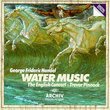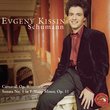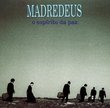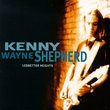| All Artists: Johann Sebastian Bach, Daniel Barenboim, English Chamber Orchestra Title: Bach: Violin Concertos Members Wishing: 0 Total Copies: 0 Label: EMI Classics Original Release Date: 1/1/2002 Re-Release Date: 8/13/2002 Genre: Classical Styles: Chamber Music, Forms & Genres, Concertos, Historical Periods, Baroque (c.1600-1750), Classical (c.1770-1830), Instruments, Reeds & Winds, Strings Number of Discs: 1 SwapaCD Credits: 1 UPCs: 724357472029, 724357472050 |
Search - Johann Sebastian Bach, Daniel Barenboim, English Chamber Orchestra :: Bach: Violin Concertos
 | Johann Sebastian Bach, Daniel Barenboim, English Chamber Orchestra Bach: Violin Concertos Genre: Classical
|
Larger Image |
CD DetailsSimilarly Requested CDs
|
CD ReviewsThe Violin Concerto No. 2 in E is more than worth it! Patrick "Sarge" Murray | Lexington, Indiana USA | 06/28/2003 (5 out of 5 stars) "Yes, I'll confess, I bought the CD just for the first three tracks, but what amazing tracks they are! Arguably, it's hard to find a better rendition of Bach's Violin Concerto No. 2 in E, particularly the first and third movements. Best of all, the first movement is not the truncated version, as one is apt to hear regarding certain recordings of Bach's concerti (e.g., the 3rd Brandenburg Concerto), but rest assured, this one is rendered in its entirety. Furthermore the price can't be beat. So, if you're in the market for recordings of these concerti, what are you waiting for?" Warm, cantabile, singing rendition of Baroque music C. Chu | 01/24/2004 (5 out of 5 stars) "I bought this CD to get the full collection of Bach Violin concertos and have been very happy with it. What a nice addition to have the two violin concerto too. I'm working on the Bach Concerto #1 in A minor and this has been a great help. Perlman's playing is clear, and beautiful, and the violin really sings in the solo sections. Zukerman and Perlman do a great job in the double concerto, with the two violins in engaged in a lively and warm conversation. You'll enjoy this CD whether to learn or relax." Good but a tad lacking somewhat. benlch | Singapore | 05/22/2004 (4 out of 5 stars) "The bach violin concertos have for me always been something ive always enjoyed listening to over and over. I suppose that is why such music is called classical music - it is timeless and still well loved after 1-2 hundred years after its 1st performance.I own 3 renditions of bach violin concertos - by Takako Nishizaki, Nigel Kennedy and this one. There is no denying that Pearlman, Baremboim and Zuckerman are big names - thats why i bought it in the 1st place. While i generally have no complaints about the playing, the sound quality and clarity and overall coordination betn soloist and orchestra all which are pretty good or outstanding, my 'grouse' is a matter of the interpretation. I kind of felt that it lacked a bit of 'bounce' or 'ooomph' so typical of baroque music since the tempo is somewhat slower compared to that played by Takako Nishizaki (my favourite) or Kennedy (fastest). I have also heard that Yehudi Menuhin also had an outstanding recording of these concertos.On the other hand, i suppose that is the beauty of classical music. There is no right or wrong interpretation of music. Everything is subject to the personal tastes of conductor and soloists - how they feel it should be played/expressed. that's why no 2 pieces sound alike. As a listener ,as to which recording is best is up to one's own personal taste. One man's meat is another man's poison."
|

 Track Listings (12) - Disc #1
Track Listings (12) - Disc #1








